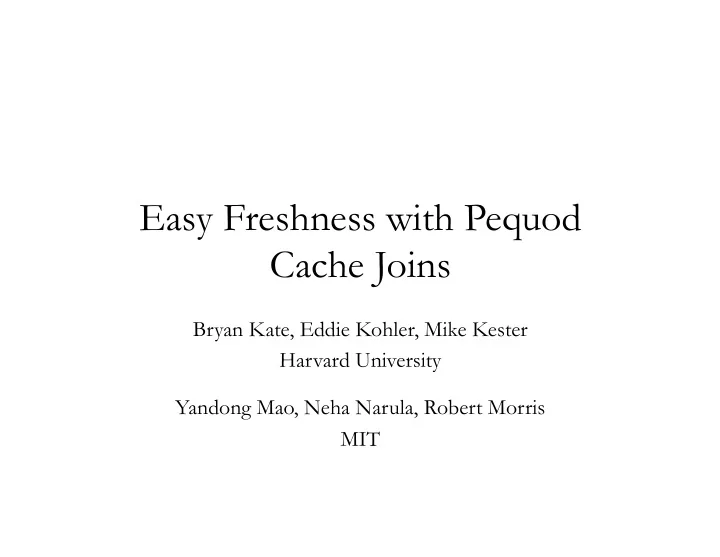

Easy Freshness with Pequod Cache Joins Bryan Kate, Eddie Kohler, Mike Kester Harvard University Yandong Mao, Neha Narula, Robert Morris MIT
tl;dr Web application caches should support materialized views natively. In-cache materialized views are easy to use and have good performance. 2
application cache • fast key-value cache – examples: memcached, Redis • offloads reads from database • managed by application developer – assume burden of maintenance 3
4
5
100 timeline checks for every new post! 6
7
8
9
10
11
12
timeline database query SELECT ¡post.time, ¡post.poster, ¡post.content ¡ ¡ ¡ ¡FROM ¡post ¡JOIN ¡sub ¡ ¡ ¡ ¡ ¡WHERE ¡sub.follows ¡= ¡post.poster ¡ ¡ ¡ ¡ ¡ ¡ ¡AND ¡sub.user ¡= ¡'bk' ¡ ¡ ¡ ¡ ¡ ¡ ¡ ¡AND ¡post.time ¡>= ¡100 ¡ ¡ ¡ ¡ORDER ¡BY ¡post.time; ¡ ¡ 13
14
timeline materialized view CREATE ¡MATERIALIZED ¡VIEW ¡tline ¡AS ¡ SELECT ¡sub.user, ¡post.time, ¡post.poster, ¡post.content ¡ ¡ ¡ ¡FROM ¡post ¡JOIN ¡sub ¡ ¡ ¡ ¡ ¡WHERE ¡sub.follows ¡= ¡post.poster; ¡ ¡ ¡ SELECT ¡* ¡FROM ¡tline ¡ ¡ ¡WHERE ¡tline.user ¡= ¡‘bk’ ¡AND ¡tline.time ¡>= ¡100 ¡ ¡ ¡ORDER ¡BY ¡tline.time; ¡ • arrange data for quick reading – computation happens in advance—good! – simple query on materialized data—good! 15
16
easy, but slow • the database becomes a bottleneck – most important job: durable storage – handling reads + writes may be too much – better to offload reads – implementation issues (locks, transactions, …) 17
18
Pequod • a distributed application cache • materialized views in a key-value cache – operations: get, put, scan, plus join • good performance and programmability 19
advanced materialized views • simple materialized views are a bad fit for caches – need advanced features from recent research • partial : only portions are materialized as needed • dynamic : portions are selected based on requests • incremental updates : track dependencies between data • eager updates • lazy updates • distributed • in an ordered key-value cache! 20
KV materialized views? CREATE ¡MATERIALIZED ¡VIEW ¡tline ¡AS ¡ SELECT ¡sub.user. ¡post.time, ¡post.poster, ¡post.content ¡ ¡ ¡ ¡FROM ¡post ¡JOIN ¡sub ¡ ¡ ¡ ¡ ¡WHERE ¡sub.follows ¡= ¡post.poster; ¡ ¡ • but Pequod only understands get, put, scan! – want key-value for performance – how to represent the relations needed for views? 21
Pequod cache joins CREATE ¡MATERIALIZED ¡VIEW ¡tline ¡AS ¡ SELECT ¡sub.user. ¡post.time, ¡post.poster, ¡post.content ¡ ¡ ¡ ¡FROM ¡post ¡JOIN ¡sub ¡ ¡ ¡ ¡ ¡WHERE ¡sub.follows ¡= ¡post.poster; ¡ ¡ tline|<user>|<time>|<poster> ¡= ¡ ¡ ¡check ¡sub|<user>|<poster> ¡ ¡ ¡copy ¡post|<poster>|<time>; 22
Pequod cache joins CREATE ¡MATERIALIZED ¡VIEW ¡tline ¡AS ¡ SELECT ¡sub.user. ¡post.time, ¡post.poster, ¡post.content ¡ ¡ ¡ ¡FROM ¡post ¡JOIN ¡sub ¡ ¡ ¡ ¡ ¡WHERE ¡sub.follows ¡= ¡post.poster; ¡ ¡ tline|<user>|<time>|<poster> ¡= ¡ ¡ ¡check ¡sub|<user>|<poster> ¡ ¡ ¡copy ¡post|<poster>|<time>; 23
Pequod cache joins CREATE ¡MATERIALIZED ¡VIEW ¡tline ¡AS ¡ SELECT ¡sub.user. ¡post.time, ¡post.poster, ¡post.content ¡ ¡ ¡ ¡FROM ¡post ¡JOIN ¡sub ¡ ¡ ¡ ¡ ¡WHERE ¡sub.follows ¡= ¡post.poster; ¡ ¡ tline|<user>|<time>|<poster> ¡= ¡ ¡ ¡check ¡sub|<user>|<poster> ¡ ¡ ¡copy ¡post|<poster>|<time>; ¡ ¡ scan(tline|bk|100, ¡tline|bk ∞ ) ¡ 24
25
scan(tline|bk|100, ¡tline|bk ∞ ) ¡ 26
scan(tline|bk|100, ¡tline|bk ∞ ) ¡ ¡ tline|<user>|<time>|<poster> ¡= ¡ ¡ ¡check ¡sub|<user>|<poster> ¡ ¡ ¡copy ¡post|<poster>|<time>; ¡ 27
28
29
30
scale • distributed Pequod scales to large data sets – key design choice: computation is local • base data is partitioned – example: sub, post “tables” • cache joins can be computed anywhere – base data transparently replicated as necessary 31
distributed deployment 32
distributed deployment (read) 33
distributed deployment (read) 34
distributed deployment (read) 35
distributed deployment (write) 36
distributed deployment (write) 37
other features • advanced cache joins – interleaved: collocate different kinds of data – stacked – materialized, non-materialized, or snapshot – aggregates • eviction • consistency 38
evaluation • Twitter-like benchmark – based on 2009 Twitter social graph – check, subscribe, post (100:10:1) • evaluate potential bottlenecks in Pequod – database omitted in experiments – clients write data directly to Pequod 39
system comparison Do cache joins have key-value cache performance? • goal: perform no worse than existing caches • compare with: – fast KV caches: Redis, memcached – DB-as-cache: Postgres (in-memory, tuned) • Postgres uses “materialized views” (triggers) 40
system comparison 350 300 QPS (thousands / s) 250 200 150 100 50 0 Pequod Redis memcached Postgres 41
scaling Pequod Will adding servers improve performance? What is the overhead of data movement? • cluster on Amazon EC2 • two-tier deployment – subscriptions, posts on “base” servers – timelines executed on “compute” servers – replication is required 42
scaling Pequod 5 QPS (millions / s) 4 3 2 1 0 12 24 36 48 Compute servers 43
scaling Pequod (overhead) • steady-state bandwidth for data movement – 10 è 16% (larger fanout) • total memory consumption – 290 è 297GB at base (subscription metadata) – 1.2 è 1.5TB at compute (duplicate data) • overhead is noticeable but not crippling 44
selected related work • DMV [Zhou et al, 2007] – partial, dynamic database materialized views • DBProxy [Amiri et al, 2002-3] – distributed cache built from databases – incremental updates to cached results • MV in PNUTS [Agrawal et al, 2009] – materialized views in a key-value store – incremental updates, not partial 45
conclusion • Pequod cache joins – programmability of materialized views – performance of a key-value cache – code release soon! github.com/bryankate 46
Recommend
More recommend